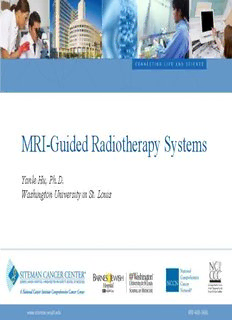
MRI-Guided Radiotherapy Systems - AMOS Online PDF
Preview MRI-Guided Radiotherapy Systems - AMOS Online
MRI-Guided Radiotherapy Systems Yanle Hu, Ph.D. Washington University in St. Louis Conflict of Interests • I don’t have personal conflict of interests. • Washington University has research and service agreements with Viewray Inc. Objectives • Motivation for MRI guided radiotherapy system • What are the technical challenges? • What is the status of current developmental work? • How do each radiotherapy system addresses those technical challenges? Background • Radiation therapy – One of the most important cancer treatment types – About 50% of cancer patients will receive radiation therapy – Contribute to approximately 40% of curative treatment • Radiation is a double-edged sword – Kill tumors – Damage healthy tissues Background • Radiotherapy treatment planning – CT simulation – Tumors and organ-at-risk delineation – Calculate radiation dose distribution – Beam optimization based on the prescription dose to the PTV and the constraint doses to the OARs – Beam setups are transferred to the radiotherapy system for patient treatment. – Highly conformal dose delivery is feasible with conformal RT or IMRT Background • Prerequisites for a successful radiotherapy treatment – Patient setup is exactly the same between treatment and simulation – Patient anatomy does not change between treatment and simulation – Internal organs and tumor does not move during radiation dose delivery • Margin is used to compensate for localization errors – Small margin → insufficient tumor coverage – Large margin → normal tissue toxicity Background • Techniques to reduce localization errors – Surface and skin markers – Portal imaging – Cone beam CT – Megavoltage CT • Techniques to reduce motion induced errors – Fiduciary markers – Optical tracking – Respiratory surrogates – Electromagnetic transponders – MRI Motivation • Advantages of using MRI as the On-board imaging unit for radiotherapy system – No ionizing radiation – Good soft tissue contrast – Capable of real time tracking – Better suitable for gated radiotherapy Technical Challenges • MRI system → Radiotherapy system – Beam generation – Beam penetration – Scatter caused by beam penetration through MRI system – Impact of Lorentz force on secondary electrons • Radiotherapy system → MRI system – Magnetic field homogeneity – Radiofrequency interference Current Developmental Efforts • MRI-guide radiotherapy systems – MRI on rail – Viewray – Bi-planar Linac-MR – MR-XRT at 1.5T
Description: